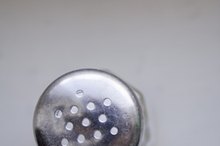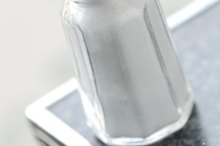What does fact checked mean?
At Healthfully, we strive to deliver objective content that is accurate and up-to-date. Our team periodically reviews articles in order to ensure content quality. The sources cited below consist of evidence from peer-reviewed journals, prominent medical organizations, academic associations, and government data.
- PubMed: Effect of Water Rinsing on Sodium Content of Selected Foods
- PubMed: Effect of Water Rinsing on Sodium Content of Selected Foods
The information contained on this site is for informational purposes only, and should not be used as a substitute for the advice of a professional health care provider. Please check with the appropriate physician regarding health questions and concerns. Although we strive to deliver accurate and up-to-date information, no guarantee to that effect is made.
Does Rinsing Tuna Get Rid of Sodium?
In a society abundant with convenience foods, it is all too easy to consume high levels of sodium. Canned goods, bagged snacks and fast food all contain salt, which can quickly exceed healthy levels. You don't have to completely avoid salt, but there are measures you can take to lower the amount you eat. Most canned tuna is loaded with sodium, but rinsing it in water reduces the quantity that it contains.
The Facts
The 2010 Dietary Guidelines for Americans suggest that you consume no more than 2,300 milligrams of sodium per day. If you are over 51, black or have health concerns such as high blood pressure, diabetes or chronic kidney disease, the recommended limit decreases to 1,500 milligrams. The average can of drained light tuna in water contains 558 milligrams of sodium 2. One can of drained light tuna packed in oil has 605 milligrams of sodium.
- The 2010 Dietary Guidelines for Americans suggest that you consume no more than 2,300 milligrams of sodium per day.
- The average can of drained light tuna in water contains 558 milligrams of sodium 2.
The Research
High-Fiber & Low-Salt Diet
Learn More
A study from the "Journal of the American Dietetic Association" tested the effects of three minutes of water rinsing on several high-sodium foods 1. The results indicated that the sodium content of canned tuna was lowered by 80 percent after the rinse. Iron content was not affected, but calcium content decreased by 50 percent. Researchers concluded that rinsing canned tuna in water clearly reduced salt levels.
- A study from the "Journal of the American Dietetic Association" tested the effects of three minutes of water rinsing on several high-sodium foods 1.
Low-sodium Tuna
You can choose to purchase low-sodium canned tuna. One can of drained light tuna in water without salt contains 82 milligrams of sodium 2. There are 86 milligrams of sodium in a can of drained light tuna in oil without salt 2. This means you get approximately 85 percent less sodium in the no salt added varieties versus the salted cans. Calcium levels appear unchanged with the low-sodium options. Nutrients will vary by brand, so always read the nutrition label on the package to know what it contains.
- You can choose to purchase low-sodium canned tuna.
- This means you get approximately 85 percent less sodium in the no salt added varieties versus the salted cans.
Reducing Salt Elsewhere
Nutritional Facts for Ahi Vs. Yellowfin Tuna
Learn More
While rinsing canned tuna or opting for low-sodium tuna are healthy options, it is wise to take a look at the other foods you are consuming throughout your day. This can help determine if there are other ways that you can cut down on your salt intake. Eating more fresh foods, using herbs and spices in place of salt for flavoring, reducing the amount of salt called for in recipes and selecting lower sodium versions of your favorite packaged foods are several ideas to consider.
Related Articles
References
- PubMed: Effect of Water Rinsing on Sodium Content of Selected Foods
- USDA National Agriculture Library: Fish, Tuna, Light, Canned in Water, Drained Solids
- Fish, tuna, light, canned in water, without salt, drained solids. FoodData Central. U.S. Department of Agriculture. Published April 1, 2019.
- Dhurmeea Z, Pethybridge H, Appadoo C, Bodin N. Lipid and fatty acid dynamics in mature female albacore tuna (Thunnus alalunga) in the western Indian Ocean. PLOS ONE. 2018. doi:10.1371/journal.pone.0194558
- Vitamin B12 or folate deficiency anaemia. National Health Service. Updated 2019.
- Sparkes C, Gibson R, Sinclair A, Else PL, Meyer BJ. Effect of low dose docosahexaenoic acid-rich fish oil on plasma lipids and lipoproteins in pre-menopausal women: A dose⁻response randomized placebo-controlled trial. Nutrients. 2018;10(10). 10.3390/nu10101460
- Simonetto M, Infante M, Sacco RL, Rundek T, Della-Morte D. A novel anti-inflammatory role of omega-3 PUFAs in prevention and treatment of atherosclerosis and vascular cognitive impairment and dementia. Nutrients. 2019;11(10). doi:10.3390/nu11102279
- Damanti S, Azzolino D, Roncaglione C, Arosio B, Rossi P, Cesari M. Efficacy of nutritional interventions as stand-alone or synergistic treatments with exercise for the management of sarcopenia. Nutrients. 2019;11(9). doi:10.3390/nu11091991
- Diabetes superfoods. American Diabetes Association. Updated 2020.
- Histamine toxicity. American Academy of Allergy, Asthma & Immunology. Updated 2020.
- ACOG practice advisory: Update on seafood consumption during pregnancy. American College of Obstetricians and Gynecologists. Updated 2017.
- Canned tuna. Seafood Health Facts: Making Smart Choices Balancing the Benefits and Risks of Seafood Consumption. Updated 2020.
- Selecting and serving fresh and frozen seafood safely. U.S. Food and Drug Administration. Updated 2019.
Writer Bio
Corinne Goff is a registered dietitian in Rhode Island who works as a nutrition consultant in private practice. She writes a nutrition blog which focuses on natural, whole foods. Goff has a bachelor of arts degree in psychology from Salve Regina University and a bachelor of science degree in nutrition from the University of Rhode Island.









